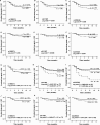Genetic variants of SP-D confer susceptibility to radiation pneumonitis in lung cancer patients undergoing thoracic radiation therapy
- PMID: 30897289
- PMCID: PMC6536953
- DOI: 10.1002/cam4.2088
Genetic variants of SP-D confer susceptibility to radiation pneumonitis in lung cancer patients undergoing thoracic radiation therapy
Abstract
Background: Surfactant protein D (SP-D) is an innate immunity molecule in the alveoli. However, the associations between genetic variants of SP-D and radiation pneumonitis (RP) have never been investigated.
Methods: The Linkage disequilibrium of SP-D and tagSNPs were analyzed by using Haploview 4.1. Eight tagSNPs were genotyped among 396 lung cancer patients who received thoracic radiation therapy with follow-up time (median [P25, P75]: 11[6, 18]) using improved multiplex ligation detection reaction (iMLDR). The associations between clinical characteristics, tagSNP alleles, genotypes, haplotypes and onset time of grade ≥2 or ≥3 RP were evaluated by using univariate and multivariate Cox proportional hazard regression model.
Results: Three tagSNPs of SP-D (rs1998374, rs911887 and rs2255326) were significantly associated with grade ≥2 RP in multivariate analysis with multiple testing (Q test). The rs199874 had a protective effect for grade ≥2 RP in the dominant model (Hazard ratio (HR), 0.575; 95% confidence interval (CI), 0.378-0.875). The homozygous mutant genotype for rs911887 had risk effect for grade ≥2 RP (HR, 2.209; 95% CI, 1.251-3.902). The A mutant allele of rs2255326 also showed an elevated risk for grade ≥2 RP (HR, 1.777; 95% CI, 1.283-2.461) and this risk effect was still significant in the recessive genetic model (HR, 3.320; 95% CI, 1.659-6.644) and dominant genetic model (HR, 1.773; 95% CI, 1.166-2.696). Compared to the lung cancer patients bearing the most common haplotype C-G-T, the patients bearing the haplotype T-A-C (rs1998374-rs2255326-rs911887) showed a significant risk of both grade ≥2 RP (HR, 1.885; 95% CI, 1.284-2.765) and grade ≥3 RP (HR, 2.256; 95% CI, 1.248-4.080).
Conclusions: Genetic variants of SP-D were associated with risk of RP development in lung cancer patients receiving thoracic radiotherapy.
Keywords: SP-D; genetic polymorphisms; lung cancer; radiation pneumonitis; susceptibility gene.
© 2019 The Authors. Cancer Medicine published by John Wiley & Sons Ltd.
Conflict of interest statement
None declared.
Figures

Similar articles
-
Genetic variants in PI3K/AKT pathway are associated with severe radiation pneumonitis in lung cancer patients treated with radiation therapy.Cancer Med. 2016 Jan;5(1):24-32. doi: 10.1002/cam4.564. Epub 2015 Dec 8. Cancer Med. 2016. PMID: 26645682 Free PMC article.
-
Genetic variants of the LIN28B gene predict severe radiation pneumonitis in patients with non-small cell lung cancer treated with definitive radiation therapy.Eur J Cancer. 2014 Jul;50(10):1706-1716. doi: 10.1016/j.ejca.2014.03.008. Epub 2014 Apr 26. Eur J Cancer. 2014. PMID: 24780874 Free PMC article.
-
Single nucleotide polymorphism at rs1982073:T869C of the TGFbeta 1 gene is associated with the risk of radiation pneumonitis in patients with non-small-cell lung cancer treated with definitive radiotherapy.J Clin Oncol. 2009 Jul 10;27(20):3370-8. doi: 10.1200/JCO.2008.20.6763. Epub 2009 Apr 20. J Clin Oncol. 2009. PMID: 19380441 Free PMC article.
-
Diagnosis and treatment of radiation induced pneumonitis in patients with lung cancer: An ESTRO clinical practice guideline.Radiother Oncol. 2025 Jun;207:110837. doi: 10.1016/j.radonc.2025.110837. Epub 2025 Apr 2. Radiother Oncol. 2025. PMID: 40185160 Review.
-
Genetic variant associations of human SP-A and SP-D with acute and chronic lung injury.Front Biosci (Landmark Ed). 2012 Jan 1;17(2):407-29. doi: 10.2741/3935. Front Biosci (Landmark Ed). 2012. PMID: 22201752 Free PMC article. Review.
Cited by
-
Risk analysis of grade ≥ 2 radiation pneumonitis based on radiotherapy timeline in stage III/IV non-small cell lung cancer treated with volumetric modulated arc therapy: a retrospective study.BMC Pulm Med. 2022 Nov 7;22(1):402. doi: 10.1186/s12890-022-02211-8. BMC Pulm Med. 2022. PMID: 36344945 Free PMC article.
-
A Novel Nomogram Model Based on Cone-Beam CT Radiomics Analysis Technology for Predicting Radiation Pneumonitis in Esophageal Cancer Patients Undergoing Radiotherapy.Front Oncol. 2020 Dec 17;10:596013. doi: 10.3389/fonc.2020.596013. eCollection 2020. Front Oncol. 2020. PMID: 33392091 Free PMC article.
-
A novel nomogram containing acute radiation esophagitis predicting radiation pneumonitis in thoracic cancer receiving radiotherapy.BMC Cancer. 2021 May 22;21(1):585. doi: 10.1186/s12885-021-08264-y. BMC Cancer. 2021. PMID: 34022830 Free PMC article.
-
Markers Useful in Monitoring Radiation-Induced Lung Injury in Lung Cancer Patients: A Review.J Pers Med. 2020 Jul 26;10(3):72. doi: 10.3390/jpm10030072. J Pers Med. 2020. PMID: 32722546 Free PMC article. Review.
-
Low dose ionizing radiation effects on the immune system.Environ Int. 2021 Apr;149:106212. doi: 10.1016/j.envint.2020.106212. Epub 2020 Dec 5. Environ Int. 2021. PMID: 33293042 Free PMC article. Review.
References
-
- Tyldesley S, Boyd C, Schulze K, Walker H, Mackillop WJ. Estimating the need for radiotherapy for lung cancer: an evidence‐based, epidemiologic approach. Int J Radiat Oncol Biol Phys. 2001;49:973‐985. - PubMed
-
- Roach M, Gandara Dr, Yuo Hs, et al. Radiation pneumonitis following combined modality therapy for lung cancer: analysis of prognostic factors. J Clin Oncol. 1995;13:2606‐2612. - PubMed
-
- Khalil AA, Hoffmann L, Moeller DS, Farr KP, Knap MM. New dose constraint reduces radiation‐induced fatal pneumonitis in locally advanced non‐small cell lung cancer patients treated with intensity‐modulated radiotherapy. Acta Oncol. 2015;54:1343‐1349. - PubMed
-
- Fleming C, Cagney DN, O'Keeffe S, Brennan SM, Armstrong JG, McClean B. Normal tissue considerations and dose‐volume constraints in the moderately hypofractionated treatment of non‐small cell lung cancer. Radiother Oncol. 2016;119:423‐431. - PubMed
Publication types
MeSH terms
Substances
LinkOut - more resources
Full Text Sources
Medical
Research Materials

